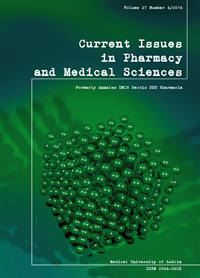The effect of thyroxin on hepatic redox equilibrium and lipid metabolism in rats treated with doxorubicin
DOI:
https://doi.org/10.1515/cipms-2015-0019Keywords:
doxorubicin, thyroxin, liver, redox equilibrium, lipid metabolismAbstract
The main side effects of the administration of doxorubicin, a widely used anticancer drug, is the generation of a reactive oxygen species (ROS) in normal cells. As a result, redox disorders and secondary oxidative stress are developed. Doxorubicin ROS generation is attributed to enzymes that are produced abundantly in hepatocytes. Oxidative stress has been a well-known risk factor of doxorubicin-related toxicity. However, in addition, according to the data collected in the last decade, changes in thyroxin status can propagate ROS generation, and, thus, initiate the doxorubicin hepatic effect. Moreover, both compounds have an impact on the cell metabolism. The aim of the study was to verify the thesis that thyroxin can modulate the effect of doxorubicin with regard to redox status and lipid metabolism disorders. In our work, we determined the ratio of NADP+/ NADPH and NAD+/NADH in liver homogenates, blood ketone bodies and triglycerides in the liver and blood in rats treated with doxorubicin and thyroxin. Our results indicate that thyroxin has an insignificant effect on NAD+/NADH, NADP+/NADPH ratios and on hepatic and blood triglycerides. Moreover, thyroxin administration normalized the level of blood ketone bodies that was disturbed by doxorubicin.
References
1. Andryskowski G., Owczarek T.: Ocena wybranych parametrów stresu oksydacyjnego u chorych z nadczynnością tarczycy Pol. Arch. Med. Wewn., 117, 285, 2007.
2. Berthiaume JM, Wallace KB.: Persistent alterations to the gene expression profile of the heart subsequent to chronic doxorubicin treatment. Cardiovascular Toxicol., 7, 178, 2007.
3. Carvalho R.A., at al.: Metabolic remodeling associated with subchronic doxorubicin cardiomyopathy. Toxicology., 270, 92, 2010.
4. Dudka J, et al.: Activity of NADPH-cytochrome P-450 reductase of the human heart, liver and lungs in the presence of (-)-epigallocatechin gallate, quercetin and resveratrol: an in vitro study. Basic Clin. Pharmacol. Toxicol., 97, 74, 2005.
5. Ferreira ALA, Matsubara LS, Matsubara BB.: Anthracycline-induced cardiotoxicity. Cardiov. Hematol. Agents Med. Chem., 6, 278, 2008.
6. Flores-Morales A., et al.: Patterns of liver gene expression governed by TRβ Mol Endocrinol., 16, 1257, 2002.
7. Garner A.P., et al.: Nitric oxide synthases catalyze the activation of redox cycling and bioreductive anticancer agents. Cancer Res., 59, 1929, 1999.
8. Halliwell B., Gutterridge J.M.C.: Free Radicals in Biology and Medicine. University Press, New York, 1999.
9. Hong Y.M., Kim H.S., Yoon H.: Serum lipid and fatty acid profiles in adriamycin-treated rats after administration of L-carnitine. Pediatr. Res., 51, 249, 2002.
10. Kerner J., et al.: Encyclopedia of biological chemistry., 2: 505-507, 2004.
11. Keyes G., Heimberg M.: Influence of thyroid status on lipid metabolism in the perfused rat liver. J. Clin. Invest., 64, 182, 1979.
12. Lebrecht D., et al.: Time-dependent and tissue-specific accumulation of mtDNA and respiratory chain defects in chronic doxorubicin cardiomyopathy. Circulation., 108, 2423, 2003.
13. Lombardi A, et al.: 3,5-Diiodo-L-thyronine regulates glucose-6-phosphate dehydrogenase activity in the rat. Endocrinology., 141, 1729, 2000.
14. Martini G., Ursini M. V.: A new lease of life for an old enzyme. Bioessays, 18, 631, 1996.
15. Merten K.E.: Modulation of cytochrome C oxidase is possibly involved in metallothionein protection from Doxorubicin cardiotoxicity. J. Pharmacol. Exp. Ther., 315, 1314, 2005.
16. Minotti G., et al.: Doxorubicin cardiotoxicity and the control of iron metabolism: quinone-dependent and independent mechanisms. Methods Enzymol., 378, 340, 2004.
17. Nohl H, Gille L, Staniek K.: The exogenous NADH dehydrogenase of heart mitochondria is the key enzyme responsible for selective cardiotoxicity of anthracyclines. Z Naturforsch., 53, 279, 1998.
18. Ogasavara Y., Funakoshi M., Ishii K.: Determination of reduced nicotinamide adenine dinucleotide phosphate concentration using high-performance liquid chromatography with fluorescence detection: ratio of the reduced form as a biomarker of oxidative stress. Biol. Pharm. Bull., 32, 1819, 2009.
19. Singal PK, Iliskovic N, Li T, Kumar D.: Adriamycin cardiomyopathy: pathophysiology and prevention. FASEB J,. 11, 931, 1997.
20. Thompson KL, et al.: Early alterations in heart gene expression profiles associated with doxorubicin cardiotoxicity in rats. Cancer Chemother Pharmacol., 66, 303, 2010.
21. Venditti P., et al.: Effect of thyroid state on lipid peroxidation, antioxidant defenses, and susceptibility to oxidative stress in rat tissues. J Endocrinol., 155, 151, 1997.
Downloads
Published
Issue
Section
License
Copyright (c) 2015 Authors

This work is licensed under a Creative Commons Attribution-NonCommercial-NoDerivatives 3.0 Unported License.


